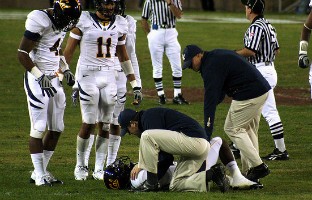Would Jesus love football?
The only good thing about the end of summer is that it's the beginning of the college football season. Once more college football is delivering thrills and surprises, with the rankings changing dramatically on a weekly basis, teams appearing out of nowhere to vie for the no. 1 ranking, and underdogs ceremoniously (college football is nothing if not ceremonious) knocking off highly favored teams. I love just about everything about the game, from the on-field heroics to the off-field pageantry.
But I make the qualification: just about everything about the game. I don't love everything. There's plenty to be cynical about when ostensibly amateur players get recruited as if they were professionals. Even a straight arrow like Ohio State coach Jim Tressel turns out to have run a fairly smarmy program. Yet it's not primarily the financially shady elements that make me ambivalent about my favorite sport. It's the sometimes dangerous levels of violence.
I played football in high school, the eight-man version practiced in rural areas of states such as Oklahoma, where I grew up. I was an offensive lineman, and one day in practice our coach decided we needed to improve our goal-line play. To challenge the first-string players, he bunched 15 reserves across from us on the one-yard line. I snapped the ball to the quarterback, delivered my block, then straightened up on my knees. It was then that a defender (my cousin, as it happened) pivoted and launched himself at the ball carrier. His heel came up under my faceguard and smashed my nose. Subsequent surgery removed about half of the cartilage from my broken, clogged snout. The flat nose that I have sported ever since is not my natural nose but a product of football.





